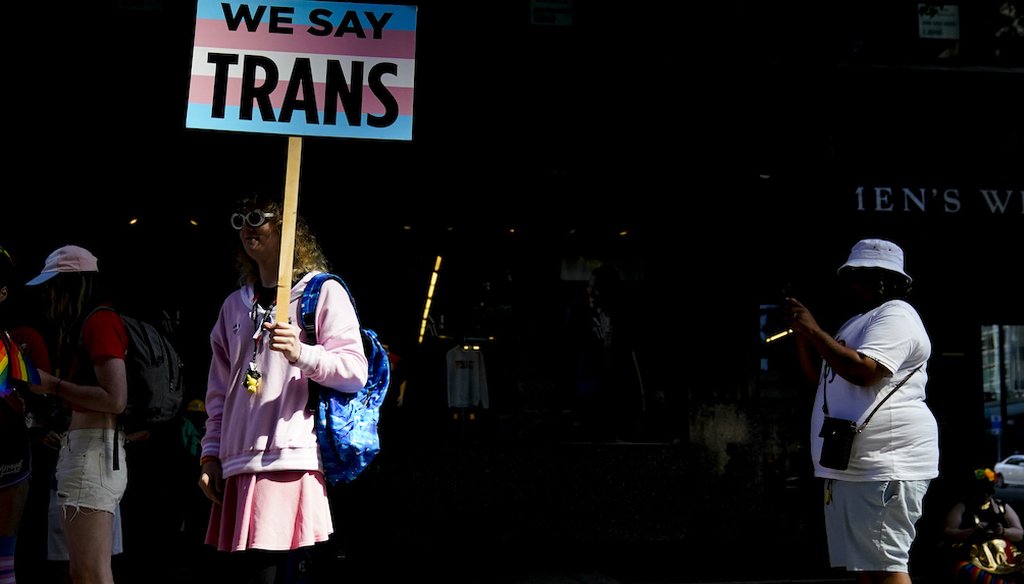Stand up for the facts!
Our only agenda is to publish the truth so you can be an informed participant in democracy.
We need your help.
I would like to contribute

A person holds a "We Say Trans" sign while waiting for the the annual Seattle Pride Parade to begin, June 25, 2023 (AP)
If Your Time is short
-
2022 survey data found that between 0.5% and 1.6% of U.S. adults identify as transgender or nonbinary. The rate is higher among young people.
-
Surveys show that when asked, people overestimate what percentage of the population is transgender, along with other minority groups. Psychologists say that cognitive quirks can explain our faulty math.
- Some research shows that our misperceptions may be consequential, driving fear of minority groups and shaping political beliefs.
State legislators introduced hundreds of 2023 bills targeting transgender Americans and affecting access to health care, education policy and sports. To hear the political discourse, it sounds at times as if the United States’ transgender population is large, booming and influential.
"Trans ideology is coming after our children," tweeted U.S. Rep. Marjorie Taylor Greene, R-Ga., on July 11.
Republican presidential candidate Vivek Ramaswamy misleadingly described being transgender as a "social contagion" and a mental illness that is spreading "like wildfire across this country."
The Twitter account Gays Against Groomers alerted its 343,000 followers July 5 to a notable figure: "New data finds that there has been a 4000% spike in students that identify as non-binary in New Jersey." Last year, it reported in another tweet that a follower said "40% of her child’s friends identify as non-binary or trans" and then emphasized the 40%.
But is the U.S. transgender population really exploding? And what does data tell us about how many trans people there are in the U.S.?
In reality, current data shows that the number of people who identify as transgender is very low: between 0.5% and 1.6% of American adults, with slightly higher numbers among young people. Yet when asked, people overestimate the number of trans people, with one survey showing the public thinks as many as 1 in 5 people — or 21% of the population — is transgender.
Psychological quirks explain why humans consistently overestimate minority populations, but research suggests this inflated perception could lead to more prejudiced beliefs and could shed light on the rise of anti-trans legislation.
So PolitiFact explored — what are the real numbers, why do we get them wrong, and why does it matter?
Determining the number of transgender people in the U.S. is not simple. Until 2021, the U.S. Census Bureau didn’t ask about sexual orientation and gender identity, so we lack large-scale demographic data. Instead, researchers rely on survey data to estimate the size of the transgender population.
In June 2022, the Williams Institute, a public policy research institute at the UCLA School of Law, released its numbers. Williams drew from U.S. Centers for Disease Control and Prevention data and estimated that 1.6 million people, or 0.6% of Americans ages 13 and older identify as transgender. Among adults, the percentage was lower — about 0.5%. And among youth 13 to 17, it was 1.4%.
Gallup, a public opinion polling company, found similar numbers in its 2022 survey of 10,000 U.S. adults. Overall, about 0.6% identified as transgender, with higher numbers among young people: 1.9% of 18-to-25-year-olds.
The highest rates were reported by Pew Research Center, which found that 1.6% of 10,188 U.S. adults surveyed identified as transgender or nonbinary, meaning they don’t identify as either men or women. The rate was higher again among young people, with 2% of people ages 18 to 29 identifying as transgender men or women, and 3% identifying as nonbinary.
Experts shared that disparities between findings may be related to some of the quirks and challenges that come with collecting data on gender identity.
For example, the Williams Institute and Gallup both asked if people identified as transgender. To some people, "transgender" may include anyone whose sex assigned at birth does not match their gender identity. But others who are nonbinary may or may not consider themselves transgender and could answer no to such a question.
The current gold standard is a two-step approach, which includes one question about assigned sex at birth and another question about current gender identity, explained Andrew Flores, American University assistant professor of government and a co-author of the Williams Institute report. This method, used by Pew in its 2022 research, captures a wider range of diverse gender identities. The more expansive question may explain the larger numbers Pew found.
But existing survey data using this two-step approach is limited, Flores said.
Conducting surveys on the topic of gender identity requires special considerations, experts said. For example, are people asked privately or publicly in front of family? Are the questions themselves understandable to people who have less familiarity with LGBTQ+ issues? And who is sponsoring the survey?
However you slice it, the numbers are low. But ask folks how many transgender people they think there are in the U.S., and the numbers are wildly out of the park.
YouGov, a United Kingdom-based polling company, asked 1,000 Americans in 2022 to estimate the size of various minority groups. "If you had to guess, what percentage of American adults are transgender?" one of the questions asked.
The average response was 21%, or 1 in 5 Americans. This overestimate was not an outlier, as respondents consistently overestimated the size of other minority groups, guessing that 27% of people are Muslim (the reality is 1%), or that 41% of Americans are Black (the reality is 12% to 13%).
A survey of 1,500 voters commissioned by Newsweek gave respondents fewer options: less than 1%, 1-3%, 3-5% or greater than 5%. Results showed that 61% of people thought more than 1% of people were transgender, with 39% of people thinking the proportion was greater than 3%.
These findings fall in line with research that shows people consistently overestimate the size of minority groups. Experts said there are two big explanations for this error.
"People are generally just really bad at making any sort of numerical estimates," said Maureen Craig, a Duke University associate research professor of psychology and neuroscience. This "innumeracy" as it is sometimes called, means that we tend to overestimate small numbers and underestimate large numbers. This pattern can be seen in the YouGov poll across all 43 questions asked.
Because minorities are by definition small, we consistently make overestimates. And the smaller the number, the worse we are at guessing, Craig said.
The other reason why we overestimate is that "our minds are built to notice everything that is uncommon or infrequent," said Rasha Kardosh, a New York University postdoctoral fellow in psychology. "People from the minority group are by definition less frequent, so our mind has the tendency to pick out their presence," and remember seeing them.
You may remember every person you’ve seen using a wheelchair. But "you tend not to think about all the people who are not using a wheelchair," said Baruch Fischhoff, Carnegie Mellon University professor of engineering and public policy. "So people are accurate at knowing what they've seen, but they tend to overestimate things because they don't factor in all the cases that we haven't seen."
Faulty estimates result from a combination of innumeracy, as well as our brain’s tendency to remember what and whom we consider novel. For transgender people, that makes for a "perfect storm," Craig said. "It's a really tiny proportion of the population, and it's in the news."
This means the public is likely to be thinking much more about transgender people, a group they were already likely to overestimate.
These overestimates may just be psychological flukes. In the YouGov poll, for example, survey designer and data journalist Taylor Orth said in an email to PolitiFact that Democrats and Republicans were "roughly equally likely as one another to over- and under-estimate the size of different groups. This indicates that misperceptions are not necessarily driven by political identity and are likely a broader phenomenon rooted in human psychology."
But other research suggests that our miscalculations and perceptions of group size may shape our political perspectives.
Several studies have found a correlation between the perceived size of a minority group and negative and adversarial attitudes about that group. This can lead to a person feeling threatened by a minority group that’s far smaller than thought. "Evidence shows that people use the size of a group as a proxy for how powerful that group is," Craig said.
Some experiments have found that exposure to information about the growth of racial minority groups prompted more negative attitudes toward racial minorities.
Experiments conducted by Craig and her colleagues have also shown that reminding people of the growth in minority populations can cause some in a majority population to express more conservative political views.
Another experiment by Kardosh found that when participants overestimated the prevalence of Black students at a fictional university, they were less likely to support policies promoting diversity. But, when participants were told the actual prevalence of Black students was 5%, people were more supportive of such policies.
Much of this research focuses on racial demographic shifts, but we may be seeing a similar trend with the LGBTQ+ population. Despite more Americans reporting that they personally know someone who is transgender and who uses gender-neutral pronouns, it appears the belief that gender is determined by sex assigned at birth is also rising, according to surveys conducted by Pew.
A Washington Post-KFF poll also found that a majority of Americans support policies that would limit access to school sports and gender-affirming medical care for transgender youth.
A year or two ago, most people may have given little thought to the topic of transgender rights. But Craig said that by drawing attention to this group, high-profile policy discussions and news coverage may be feeding people’s outsized perceptions and sense of urgency over transgender issues.
"It's not just that people are making these estimates and then reacting," Craig said. "It's also the policies that are being proposed that make people think about this as an issue."
PolitiFact reporters Louis Jacobson, Sevana Wenn, and Sofia Bliss-Carrascosa contributed to this story.
Our Sources
Email interview with Andrew Flores, assistant professor of government at American University, July 6, 2023
Interview with Maureen Craig, associate research professor of psychology and neuroscience at Duke University, July 7, 2023
Interview with Rasha Kardosh, a postdoctoral fellow in psychology at New York University, July 7, 2023
Interview with Baruch Fischhoff, professor of engineering and pblic policy at Carnegie Mellon University, July 7, 2023
Email Interview with Taylor Orth, senior survey data journalist at YouGov, July 10, 2023
Interview with Juliana Horowitz, associate director of social and demographic trends research, July 7, 2023
Interview with Linas Mitchell, psychology department instructor at Loyola University of Chicago, July 7, 2023
Email Interview with Charles Franklin, professor of law and public policy at Marquette University Law School, July 6, 2023
Tweet (archived), July 5, 2023
Tweet (archived), Aug. 7, 2022
Newsmax, "Teacher claims entire classroom of second graders switched pronouns," July 22, 2022
NPR, "Trump officials 'did not want' census survey to ask about sexual orientation," Sept. 20, 2018
The Public Opinion Quarterly, "Innumeracy About Minority Populations," 1993
Ethnic and Racial Studies, "The perception of ethnic diversity and anti-immigrant sentiments: A multilevel analysis of local communities in Belgium," January 2015
Social Forces, "Distorted Nation: Perceptions of racial/ethnic group sizes and attitudes toward immigrants and other minorities," December 2005
Personality and Social Psychology Bulletin, "More diverse yet less tolerant? How the increasingly diverse racial landscape affects white Americans' racial attitudes," June 2014
Group Processes & Intergroup Relations, "Political ideology moderates white Americans’ reactions to racial demographic change," September 2021
Social Psychological and Personality Science, "Hispanic population growth engenders conservative shift among non-Hispanic racial minorities," June 15, 2017
Psychological Science, "On the precipice of a "majority-minority" America," 2014
The Washington Post, "Most Americans support anti-trans policies favored by GOP, poll shows," May 6, 2023
YouGov, "From millionaires to Muslims, small subgroups of the population seem much larger to many Americans," March 15, 2022
Psychonomic Bulletin & Review, "Bias and ignorance in demographic perception," Aug. 31, 2017
UCLA School of Law, the Williams Institute, "How many adults and youth identify as transgender in the United States?" June 2022
Gallup, "U.S. LGBT Identification Steady at 7.2%," Feb. 22, 2023
Pew Research Center, "About 5% of young adults in U.S. are transgender or nonbinary," June 7, 2022
American Journal of Public Health, "Transgender population size in the United States: a meta-regression of population-based probability samples,"
The New York Times, "Report reveals sharp rise in transgender young people in the U.S." June 10, 2022
U.S. Census Bureau, Census survey now asks about sexual orientation, gender identity, Aug. 5, 2021
Newsweek, "What Americans get wrong about transgender people," June 14, 2023
Gallup Americans still greatly overestimate U.S. gay population, June 27, 2019
Scientific American, People think minority groups are bigger than they really are, April 27, 2022
Bloomberg News, Americans vastly overestimate how diverse the country really is, Oct. 22, 2013
The Washington Post, Americans vastly overestimate the number of immigrants. But what if it doesn’t matter?, June 22, 2018
PNAS, "Minority salience and the overestimation of individuals from minority groups in perception and memory," March 14, 2023
Pew Research Center, Americans’ complex views on gender identity and transgender issues, June 28, 2022
Pew Research Center, Rising shares of U.S. adults know someone who is transgender orgoes by gender-neutral pronouns, July 27, 2021
Psychology Today, "Why we see what we want to see," July 9, 2019
Human Rights Campaign, "Roundup of anti-LGBTQ+ legislation advancing in states across the country," May 23, 2023


























